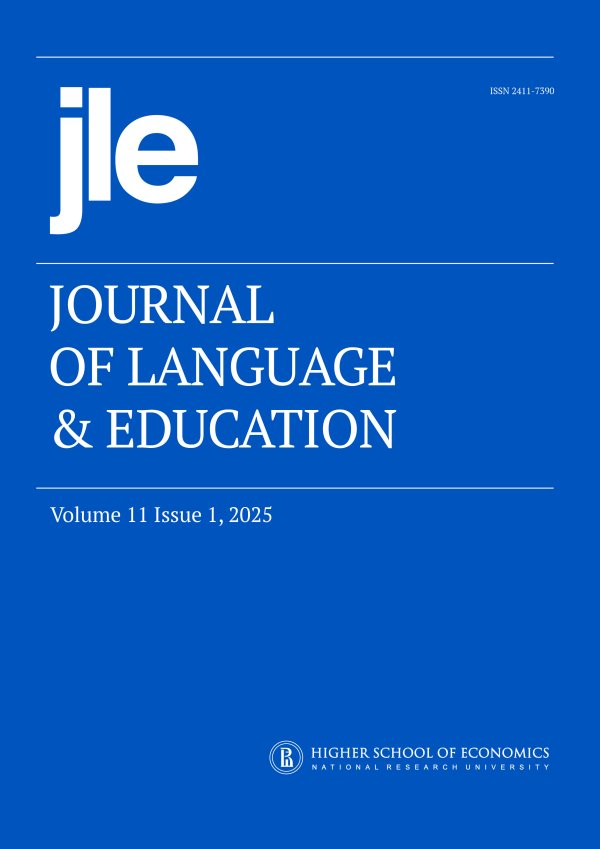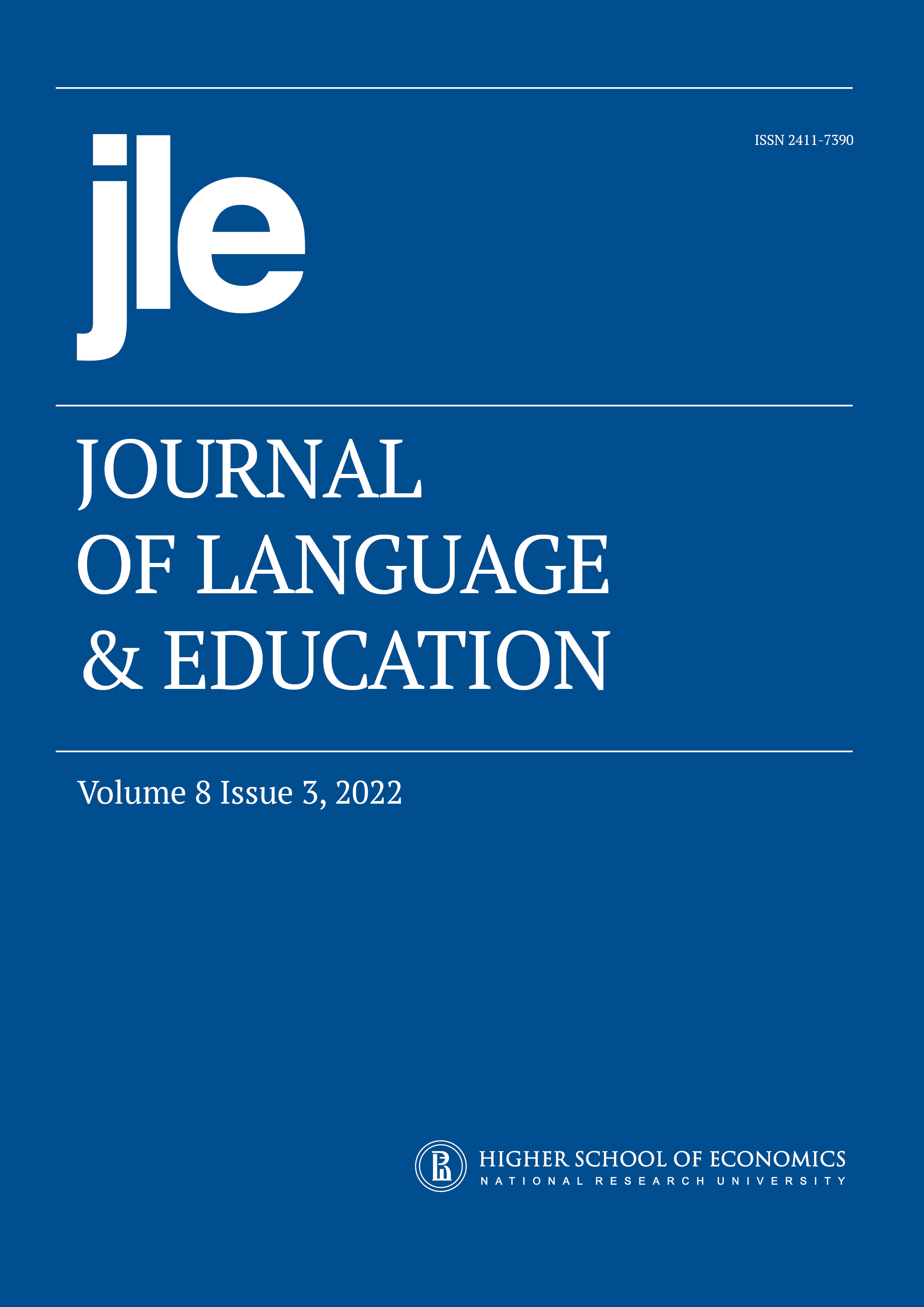Взаимодействие переменных, влияющих на навыки определения: Расширение предыдущих исследований по определению слов
- Авторы: Gavriilidou Z.1, Markos A.1, Dourou C.1
-
Учреждения:
- Democritus University of Thrace
- Выпуск: Том 8, № 3 (2022)
- Страницы: 65-80
- Раздел: Оригинальное исследование
- URL: https://journal-vniispk.ru/2411-7390/article/view/299384
- DOI: https://doi.org/10.17323/jle.2022.12901
- ID: 299384
Цитировать
Полный текст
Аннотация
Введение и цель. Учитывая, что навыки определения тесно связаны с грамотностью и пониманием прочитанного, целью этого исследования было расширить существующую литературу по навыкам определения путем эмпирического исследования влияния новых параметров, которые могут повлиять на определения слов и типы содержания и формы определений, такие как грамматические категории, структура слова и семантические характеристики.
Методы. Выборка состояла из 5152 записанных устных определений, составленных 322 лицами (дошкольниками, детьми школьного возраста, студентами университетов и взрослыми), которых попросили дать устное определение 16 словам. Определения были расшифрованы и оценены по шести балльной шкале вместе с последовательностью, отражающей путь развития определений.
Результаты. Результаты показали значительное взаимодействие между грамматической категорией и структурой слова для содержания и формы, а также между структурой слова и семантическими характеристиками только для содержания. Кроме того, грамматическая категория, структура слова и семантические характеристики были тесно связаны с конкретными типами определений для содержания и формы.
Выводы. Эта статья расширяет наши знания о навыках определения и предлагает новое понимание переменных, влияющих на выработку определений.
Об авторах
Z. Gavriilidou
Democritus University of Thrace
Email: zoegab@otenet.gr
ORCID iD: 0000-0002-5975-6852
A. Markos
Democritus University of Thrace
Email: amarkos@eled.duth.gr
ORCID iD: 0000-0002-4204-3573
C. Dourou
Democritus University of Thrace
Автор, ответственный за переписку.
Email: chysadr@yahoo.com
ORCID iD: 0000-0002-0767-6455
Список литературы
- Anderson,R. C., & Freebody, P. (1981). Vocabulary knowledge. In J. T. Guthrie (Ed.), Comprehension and teaching: Research reviews (pp. 97-117).International Reading Association.
- Anglin, J. (1977). Word, object and conceptual development. Norton.
- Artuso, C., Palladino, P., Valentini, P. & Belacchi, C. (2021). Definitional skills as a bridge towards school achievement. Sustainability, 14(1). DOI: https://doi.org/10.3390/su14010286
- Belacchi, C., & Benelli, B. (2017). A mosaic is not a place where you go to see pictures': On the nature of definitions and the development of definitional skills. Rivista Di Psicolinguistica Applicata, 17(1), 71-91.
- Benelli, B., Arcuri, L., & Marchesini, G. (1988). Cognitive and linguistic factors in the development of word definitions. Journal of Child Language, 15(3), 619-635. DOI: https://doi.org/10.1017/S0305000900012599
- Benelli, B., Belacchi C., Gini, G., & Lucangeli, D. (2006). To define means to say what you know about thing: The development of definitional skills as metalinguistic acquisition. Child Language, 33(1), 71-97. DOI: https://doi.org/10.1017/S0305000905007312
- Clark, E. V. (1981). Lexical innovations: How children learn to create new words. In W. Deutsch (Ed.), The child's construction of language (pp. 299-328). Academic Press.
- Clark, E. V. (1998). The acquisition of morphology. In A. J. Spencer & A. M. Zwicky (Eds.), Handbook of morphology (pp. 374-389). Blackwell.
- Clark, E. V., & Berman, R. A. (1984). Structure and use in the acquisition of word formation. Language, 60(3), 542-590.
- Clark, E. V. & Berman, R. A. (1987). Types of linguistic knowledge: Interpreting and producing compound nouns. Journal of Child Language, 14, 547-67. DOI: https://doi.org/10.1017/S030500090001028X
- Clark, E. V., & Hecht, B. F. (1982). Learning to coin agent and instrument nouns. Cognition, 12(1), 1-24. DOI: https://doi.org/10.1016/0010-0277(82)90027-0
- Dosi, I. & Gavriilidou, Z. (2020). The role of cognitive abilities in the development of definitions by children with and without Developmental Language Disorder. Journal of Psycholinguistic Research, 49, 761-777. DOI: https://doi.org/10.1007/s10936-020-09711-w
- Dosi, I., Gavriilidou, Z. & Dourou, A. (2021). Definitional skills of learners with and without developmental language disorder.International Journal of Learning, Teaching and Educational Research, 20(10), 193-216. DOI: https://doi.org/10.26803/ijlter.20.10.11
- Dourou, C. (2019). The comparison of definition ability of different age groups [Unpublished doctoral dissertation]. Democritus University of Thrace.
- Dourou, C., Gavriilidou, Z. & Markos, A. (2020). Definitional skills and preferred definition types according to age, gender, educational level and career orientation.International Journal of Research Studies in Education, 9(2), 29-49. DOI: https://doi.org/10.5861/ijrse.2020.5021
- El Euch, S. (2007). Concreteness and language effects in the quality of written definitions in L1, L2 and L3.International Journal of Multilingualism, 4(3), 198-216. DOI: https://doi.org/10.2167/ijm071.0
- Gandia, A.M. (2016). On word definition in children and adults: Effects of word category and level of abstraction [Doctoral dissertation]. Universitat de Barcelona.
- Gavriilidou, Z. (2015). The development of noun, verb and adjective definitional awareness in Greek preschoolers. Journal of Applied Linguistics, 30, 44-58.
- Gentner, D. (1982). Why nouns are learned before verbs: Linguistic relativity vs. natural partitioning. In S. A. Kuczaj (Ed.), Language development: Language, culture, and cognition (pp. 301-335). Erlbaum.
- Graesser, A. C., Hopkinson, P. & Schmid, C. (1987). Differences in interconcept organization between nouns and verbs. Journal of Memory and Language, 26(2), 242-253. DOI: https://doi.org/10.1016/0749-596x(87)90126-4
- Greenacre, M. (2007). Correspondence analysis in practice. CRC press.
- Greenacre, M. (2013). Contribution biplots. Journal of Computational and Graphical Statistics, 22(1), 107-122.
- Gutierrez-Clellen, V., & DeCurtis, L. (1999). Word definitional skills in Spanish speaking children with language impairment.Communication Disorders Quarterly, 21(1), 23-31. DOI: https://doi.org/10.1177/152574019902100104
- Huttenlocher, J., & Lui, F. (1979). The semantic organization of some simple nouns and verbs. Journal of Verbal Learning and Verbal Behavior, 18, 141-162. DOI: https://doi.org/10.1016/S0022-5371(79)90091-4
- Johnson, C. J., & Anglin, J. M. (1995). Qualitative developments in the content and form of children's definitions. Journal of Speech and Hearing Research, 38, 612-629. DOI: https://doi.org/10.1044/jshr.3803.612
- Kassambara, I., & Mundt, F. (2020). Factoextra: Extract and visualize the results of multivariate data analyses. Version 1.0.7. https://CRAN.R-project.org/package=factoextra.
- Krott, A. & Nicoladis, E. (2005). Large constituent families help children parse compounds. Journal of Child Language, 32(1), 139-58. https://psycnet.apa.org/doi/. DOI: https://doi.org/10.1017/S0305000904006622
- Kurland, B.F. & Snow, C. (1997). Longitudinal measurement of growth in definitional skill. Journal of Child Language 24, 603-26. DOI: https://doi.org/10.1017/s0305000997003243
- Litowitz, B. (1977). Learning to make definitions. Journal of Child Language, 4(2), 289-304. DOI: https://doi.org/10.1017/S0305000900001665
- Marinellie, S. (2010). Improving children's formal word definitions: A feasibility study. Child Language Teaching and Therapy, 26(1), 23-37. DOI: https://doi.org/10.1177/0265659009349970
- Marinellie, S.A. & Chan Y. (2006). The effect of word frequency of noun and verb definitions: A developmental study. Journal of Speech, Language, and Hearing Research, 49(5), 1001-1021. DOI: https://doi.org/10.1044/1092-4388(2006/072)
- Marinellie, S. A., & Johnson, C. (2002). Definitional skill in school-age children with specific language impairment. Journal of Communication Disorders, 35(3), 241-259. DOI: https://doi.org/10.1016/S0021-9924(02)00056-4
- Marinellie, S. A., & Johnson, C. (2003). Adjective definitions and the influence of word frequency. Journal of Speech, Language & Hearing Research, 46(5), 1061-76. DOI: https://doi.org/10.1044/1092-4388(2003/084)
- Marinellie, S. A., & Johnson C. (2004). Nouns and verbs: A comparison of definitional style. Journal of Psycholinguistic Research, 33(3), 217-235. https://doi.org/10.1023/B:JOPR.0000027963.80639.88.
- Markman, E.M. (1989). Categorization and naming in children: Problems of induction. MIT Press.
- Markowitz, J., & Franz, S. (1988). The development of defining style.International Journal of Lexicography, 1, 253-267.
- Marshall, C. R., & van der Lely, H. K. J. (2007). Derivational morphology in children with grammatical-specific language impairment. Clinical Linguistics & Phonetics, 21, 71-91. DOI: https://doi.org/10.1080/02699200600594491
- ΜcGhee-Bidlack, B. (1991). The development of noun definitions: A metalinguistic analysis. Journal of Child Language, 18, 417-434. DOI: https://doi.org/10.1017/S0305000900011132
- Miller, G. A. (1991). The science of words. Freeman.
- Nation, K. & Cocksey, J. (2009). The relationship between knowing a word and reading it aloud in children's word reading development. Journal of Experimental Child Psychology, 103(3), 296-308. https://psycnet.apa.org/doi/. DOI: https://doi.org/10.1016/j.jecp.2009.03.004
- Nicoladis, E. (2006). Preschool children's acquisition of compounds. In G. Libben & G. Jarema (Eds.), The representation and processing of compound words (pp. 96-124). Oxford University Press.
- Nicoladis, E., & Krott, A. (2007). Family size and French-speaking children's segmentation of existing compounds. Language Learning, 57(2), 201-28. DOI: https://doi.org/10.1111/j.1467-9922.2007.00407.x
- Nippold. M. A. (1995). School-age children and adolescents norms for word definition. Journal of Language, Speech, and Hearing Services in Schools, 26(4), 320-325. https://psycnet.apa.org/doi/. DOI: https://doi.org/10.1044/0161-1461.2604.320
- Nippold, M. A., Hegel, S., Sohlberg, M. M., & Schwarz, I. (1999). Defining abstract entities: Development in preadolescents, adolescents, and young adults. Journal of Speech, Language, and Hearing Research, 42, 473-481. DOI: https://doi.org/10.1044/jslhr.4202.473
- Ralli, A. (2005). Morphology. Patakis.
- Ralli, A. (2013).Compounding in modern Greek. Springer. DOI: https://doi.org/10.1007/978-94-007-4960-3
- Sadoski, M., Kealy, W. A., Goetz, E. T., & Paivio, A. (1997). Concreteness and imagery effects in the written composition of definitions. Journal of Educational Psychology, 89(3), 518-526. doi/. DOI: https://doi.org/10.1037/0022-0663.89.3.518
- Snow, C. E. (1990). The development of definitional skill. Journal of Child Language, 17(3), 697-710. DOI: https://doi.org/10.1017/S0305000900010953
- Snow, C. E., Cancini, H., Gonzalez, P., & Shriberg, E. (1989). Giving formal definitions: An oral language correlate of school literacy. In D. Bloome (Ed.), Literacy in classrooms (pp. 233-249). Ablex.
- Strik Lievers, F., Bolognesi, M., & Winter, B. (2021). The linguistic dimensions of concrete and abstract concepts: lexical category, morphological structure, countability, and etymology. Cognitive Linguistics, 32(4), 641-670. DOI: https://doi.org/10.1515/cog-2021-0007
- Thorndike, R. L., Hagen, E. P., & Sattler, J. M. (1986). Technical manual: Stanford-Binet Intelligence Scale (4th ed.). Riverside.
- Watson, R. (1985). Towards a theory of definition. Journal of Child Language, 12(1), 181-197. DOI: https://doi.org/10.1017/S0305000900006309
- Wehren, A., De Lisi, R., & Arnold, M. (1981). The development of noun definition. Journal of Child Language, 8, 165-175. DOI: https://doi.org/10.1017/S0305000900003081
Дополнительные файлы











